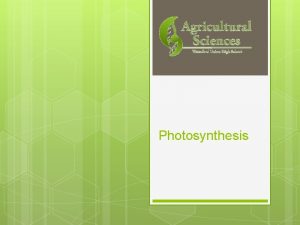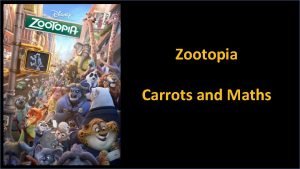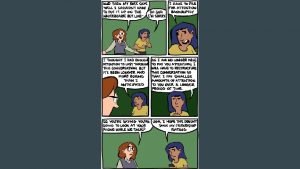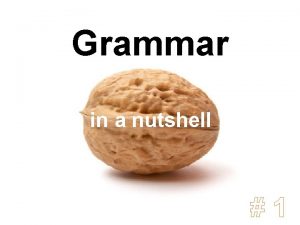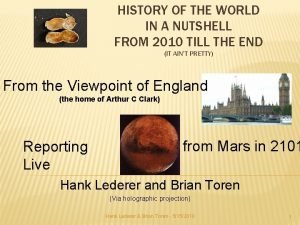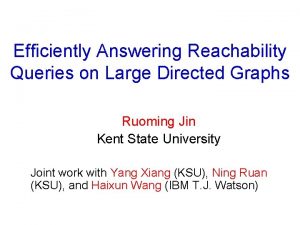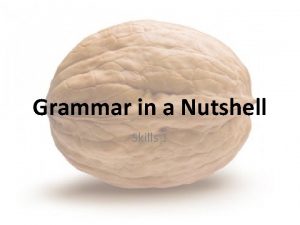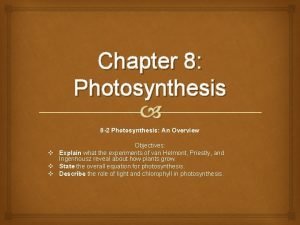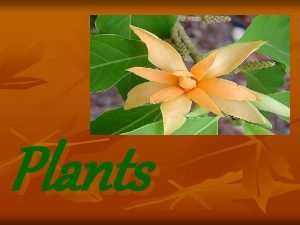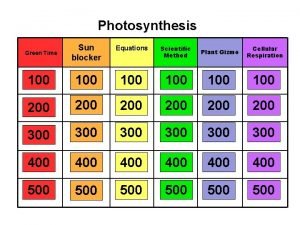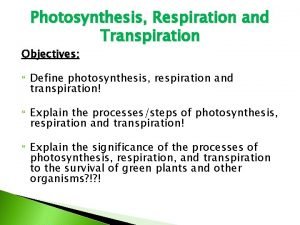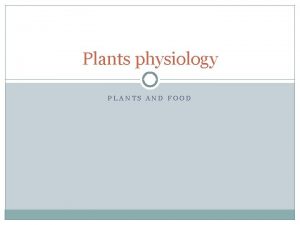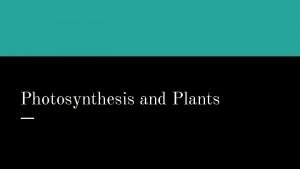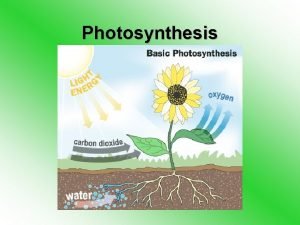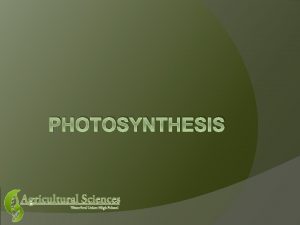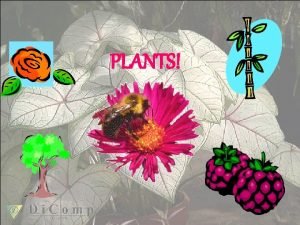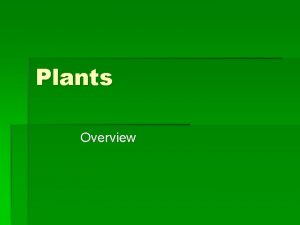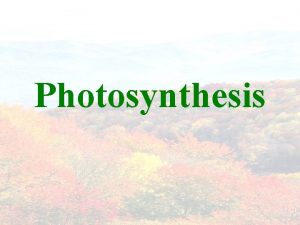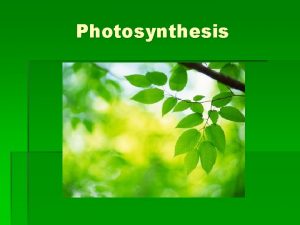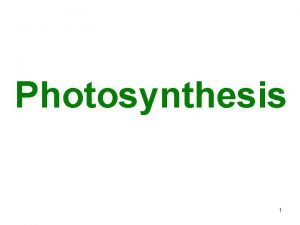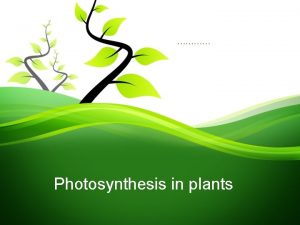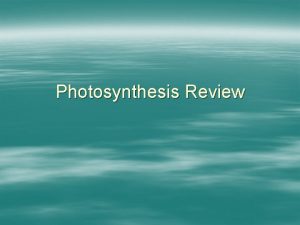Photosynthesis Overview of Photosynthesis in a nutshell Plants





















- Slides: 21

Photosynthesis

Overview of Photosynthesis in a nutshell: Plants absorb light and use it to separate hydrogen from a water molecule. The oxygen that remains is released as O 2. The hydrogen from water is used to turn ATP Synthase so that it can make ATP powers the process that creates a glucose molecule. Photosynthesis equation: 6 CO 2 + 6 H 2 O = C 6 H 12 O 6 + 6 O 2 Plants absorb H 2 O and CO 2. Plants produce glucose (C 6 H 12 O 6) and release O 2 Source: phschool. com

O 2 Photosynthesis in a nutshell… + H OH+ H Glucose ●Sunlight is used to split water into H+ and oxygen. ● H+ powers ATP Synthase. ● ATP powers the production of glucose from H+ and CO 2.

The Plant Cell The plant cell. The plant cell is very similar to the animal cell. Each cell has similar organelles such as the mitochondria, the nucleus, ribosomes, and a cell membrane. Both kinds of cells use ATP as their primary source of energy. Both cells primarily use hydrogen from glucose to power the production of ATP in the mitochondria. However, there are differences (next slide).

Plant Cells vs. Animal Cells Plant cells have a cell wall. Outside of their cell membrane, plants have a rigid cell wall made of cellulose. This cell wall protects the plant cell inside. The cell wall also provides structure and support for the plant. The cell wall acts much a like a skeleton does for vertebrate animals. Plants have chloroplasts (the cellular organelle where photosynthesis occurs). Chloroplasts are a cellular organelle (just like the mitochondria is an organelle). Chloroplasts can use light energy (or photons) to power the removal of hydrogen from water This hydrogen is used to turn ATP synthase to make ATP. The ATP is used to power the assembly of a glucose molecule.

Parts of a Chloroplast The chloroplast has two main parts: The thylakoids: these look like stacks of green pancakes. This is where water molecules are split, hydrogen is stored, and where ATP Synthase produces ATP. The stroma: this is the ‘empty space’ around the thylakoids. This is where the glucose molecule is assembled. Source: withfriendship. com

Thylakoids The thylakoids store hydrogen. Thylakoids are lined with a green pigment called chlorophyll. Chlorophyll can absorb the energy of the light (photons). The energy of light photons is used to separate the hydrogen from the oxygen on a water molecule. The hydrogen is stored inside thylakoids. The oxygen is released as O 2. Source: faculty. clintoncc. suny. edu

Thylakoids and ATP Synthase Thylakoids membrane. have ATP Synthase on their outside The hydrogen from water is used to turn this ATP Synthase to make ATP. The ATP from the thylakoids will be used for only one purpose: to power the process in which glucose molecules are produced. Thylakoids are found in ‘stacks’ called grana. The thylakoid is the ‘thin green pancake’. The grana is the ‘group of pancakes’ Source: faculty. clintoncc. suny. edu

Chloroplasts vs. Mitochondria The thylakoids of chloroplasts have the same function as the intermembrane space of the mitochondria: they store hydrogen so that it can turn ATP Synthase and make ATP. However, the ATP in the chloroplast has only one purpose – to power the assembly of glucose molecules. The chloroplast ATP is not used for any other purpose than this. Mitochondria Chloroplast Source: www. eplantscience. com

Light Reaction & Calvin Cycle Photosynthesis is composed of two processes: the Light Reaction and the Calvin Cycle. The first process is called the Light Reaction. This process occurs in the thylakoids. In this process, photons (light energy) are absorbed by the chlorophyll pigments found on the surface of the thylakoid. This light energy is used to remove the hydrogen from water. Hydrogen is then moved inside thylakoid. Similar to respiration, the hydrogen protons want to get out of the thylakoid. The only way for hydrogen to escape is through ATP Synthase that is found on the membrane of the thylakoid. Source: biologytb. net 23. net

Light Reaction As hydrogen moves through ATP Synthase, it turns this molecule. As ATP Synthase turns, it produces ATP from ADP and Pi. When this happens in a chloroplast, it is called photophosphorylation (which literally means ‘phosphorylation by light energy’). ATP produced during the Light Reaction will be used to power the assembly of glucose during the Calvin Cycle. The hydrogen that powered ATP Synthase during photophosphorylation is then added to the glucose molecule during the Calvin Cycle Source: biologytb. net 23. net

Calvin Cycle The second process is called the Calvin Cycle. The Calvin Cycle is the process in which glucose is assembled from CO 2 and hydrogen. While the light reaction occurred in the thylakoid (green pancakes), the Calvin Cycle occurs in the stroma (empty space around the thylakoids). Hydrogen used during the Light Reaction will be picked up by a molecule called NADP+ after it passes through ATP Synthase. NADP+ will “take on” hydrogen and electrons. These will be combined with carbon dioxide during the Calvin Cycle to produce glucose. Source: blogs. scientificamerican. com

Calvin Cycle As NADP+ and ADP bump into the thylakoid membrane, they will continue to be re converted into NADPH and ATP by the processes of the Light Reaction. NADP+ is almost identical to NAD+ from cellular respiration. NADP+ performs the same function as NAD+: the transport of hydrogen. Source: hyperphysics. phy-astr. gsu. edu

Absorption of CO 2 The Calvin Cycle begins by absorbing CO 2 from the air. The carbon and oxygen molecules are separated, and the oxygen is released. Carbon (from carbon dioxide) is then added to a molecule called Ru. BP is a five carbon molecule that accepts the carbon from CO 2. “Ru. BP: the five-carbon cookie” Source: www 2. estrellamountain. edu

Ru. BP and G 3 P Once hydrogen and a carbon atom are added to Ru. BP (which now has 6 carbon atoms), this molecule will split in half. Each 3 carbon molecule is called G 3 P is the precursor to all molecules produced by a plant cell. Each of the two G 3 P’s that form has a specific job: One G 3 P will be used to re form Ru. BP so that it can continue to accept carbon from carbon dioxide. The other G 3 P will be combined with another G 3 P to form glucose. G 3 P’s can also be used to make any other molecule produced by the plant cell. Source: en. wikipedia. org

Calvin Cycle, in detail 1. CO 2 is absorbed. Carbon is separated from oxygen. O 2 is released. 2. The carbon atom separated from CO 2 is combined with 5 carbon Ru. BP. 3. The 6 carbon molecule is split into two 3 carbon molecules (G 3 P). One G 3 P is used to make sugars or other plant molecules. The other is used to re make Ru. BP

The Calvin Cycle is powered by ATP (not shown) Calvin Cycle 1. CO 2 is absorbed. Carbon is separated from oxygen. O 2 is released. 2. The carbon atom separated from CO 2 is combined with 5 carbon Ru. BP. 3. The 6 carbon molecule is split into two 3 carbon molecules (G 3 P). One G 3 P is used to make sugars or other plant molecules. The other is used to re make Ru. BP. nd a ted the a cre d to e r P, to bin CO 2 B Ru ady on in re arb c y to a ir w ose. e h n t gluc o P’s ming 3 G co be for explanations Click

Steps of Photosynthesis Step 1: water is absorbed by the chloroplast of a plant cell. Step 2: (light reaction) a water molecule is split into hydrogen and oxygen by the energy of photons. This light energy absorbed by the chlorophyll pigment. Step 3: (light reaction) hydrogen is moved into the thylakoids by the electron transport system. Step 4: (light reaction) hydrogen moves through ATP Synthase; as it turns, ATP Synthase produces ATP from ADP and Pi through a process called photophosphorylation. Step 5: (light reaction) NADP+ picks up hydrogen that has moved through ATP Synthase.

Steps of Photosynthesis Step 6: (Calvin Cycle) CO 2 is absorbed by the chloroplast organelle. Step 7: (Calvin Cycle) the carbon atom is removed from CO 2 and added to five carbon Ru. BP molecule. Step 8: (Calvin Cycle) Ru. BP is split in half to form two G 3 P molecules. Step 9: (Calvin Cycle) one G 3 P is combined with another different G 3 P to form glucose. Note: many G 3 P’s are produced simultaneously in the stroma. Step 10: (Calvin Cycle) the other G 3 P bonds with more G 3 P’s to reform Ru. BP. If Ru. BP was not reformed, the Calvin Cycle would stop.

Photosynthesis (Light Reaction & Calvin Cycle) Calvin Cycle: CO 2 combines with Ru. BP to make 2 G 3 P’s. and then glucose sugar. H+ atoms are added to the glucose molecule. Light Reaction: light energy is used to split water; the H+ is used to power ATP production in ATP Synthase. ATP is made; H+ is picked up by NADP+ to form NADPH. It is taken to the stroma to be added to CO 2 to make glucose.

Applications to Agriculture Photosynthesis and respiration are the key motivations behind many practices in crop production. Crops need proper soil moisture in order to provide a source of hydrogen to power the ATP production needed for photophosphorylation. Crops need sunlight in order to power the removal of hydrogen from water during photophosphorylation. Crops need proper soil aeration to provide oxygen to their roots (which cannot photosynthesize) so that they can acquire the oxygen they need for cellular respiration. Soils need to have adequate levels of phosphorus from fertilizers so that plant cells have access to the phosphate they need to produce ATP (for both respiration and for photosynthesis).
 Photosynthesis in a nutshell
Photosynthesis in a nutshell Zootopia rules
Zootopia rules Web design in a nutshell
Web design in a nutshell Itil in a nutshell
Itil in a nutshell How to write links in apa format
How to write links in apa format Ilya sutskever
Ilya sutskever Grammar in a nutshell
Grammar in a nutshell James webb telescope
James webb telescope Bfs in a nutshell
Bfs in a nutshell Tenses in a nutshell
Tenses in a nutshell Section 8-2 photosynthesis an overview answers
Section 8-2 photosynthesis an overview answers Chapter 9 lesson 2 photosynthesis an overview
Chapter 9 lesson 2 photosynthesis an overview Overview of plants
Overview of plants The food that plants produce during photosynthesis is
The food that plants produce during photosynthesis is Definition of photosynthesis
Definition of photosynthesis Where does photosynthesis happen
Where does photosynthesis happen Green plants make their own food by photosynthesis
Green plants make their own food by photosynthesis Photosynthesis equation
Photosynthesis equation Vascular vs nonvascular plants
Vascular vs nonvascular plants Vascular vs nonvascular plants
Vascular vs nonvascular plants Characteristics of non-flowering plants
Characteristics of non-flowering plants Real time interaction management
Real time interaction management
